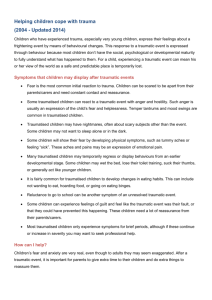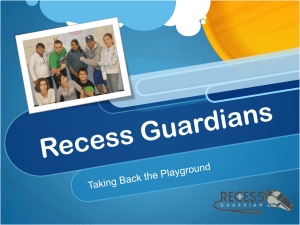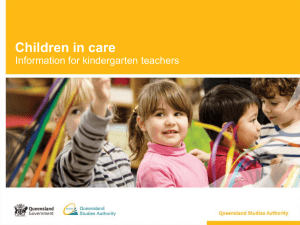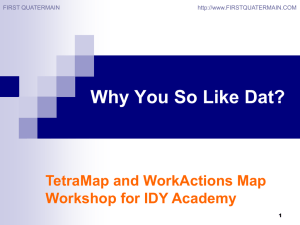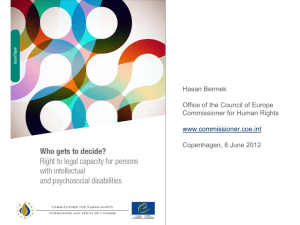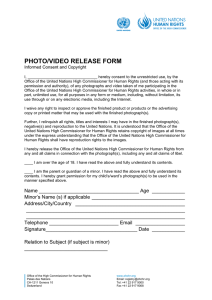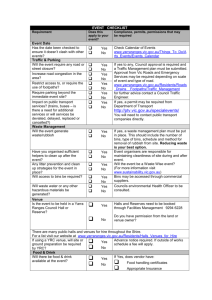ToolboxTalk 3 _PP
advertisement
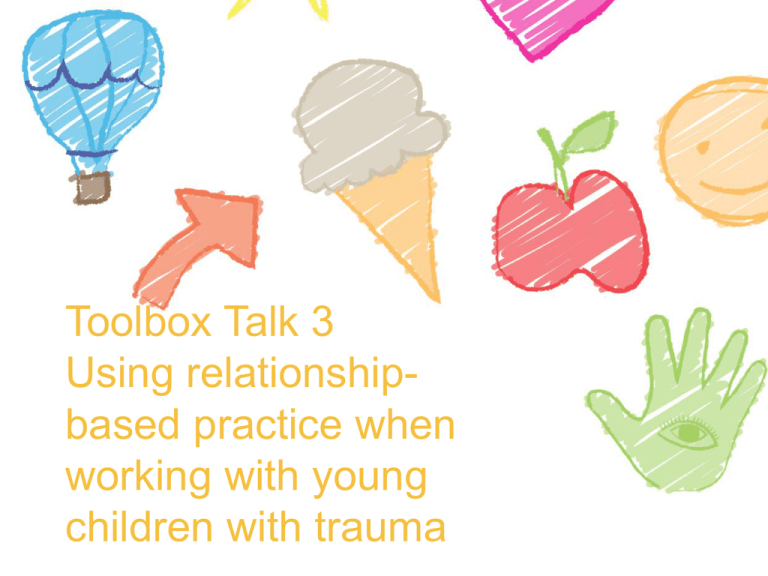
Toolbox Talk 3 Using relationshipbased practice when working with young children with trauma Recognising the signs • the signs of trauma that may result from: – family violence – substance abuse such as drugs and/or alcohol – mental health issues in parents or carers – neglect Creating connections The central concept in working with these children is to be in control of the relationship without being controlling. You should be the one to set the tone, rhythm and emotional quality. Source: adapted from the Child Safety Commissioner, Calmer Classrooms − a guide to working with traumatised children, 2007, www.kids.vic.gov.au, p.18. Understanding the child • Ask if there is anything happening in the child’s life that may be contributing to their behaviour e.G. Difficulty sleeping could contribute to behaviours • Ask the parent/carer if the service or school can help • Advise the parent/carer that you are available to help • Provide information about accessing specialist support services e.G. Psychological support Understanding the child • Maintain a high level of physical presence, support and supervision • Keep the child close ( this may mean walking with them to help them calm down, keeping a close presence with appropriate discussion) Managing your own reactions • If you feel yourself becoming angry or feeling hurt or rejected, take a moment to reflect, calm yourself and then come back to the interaction • If you feel you are losing it, ask for help or get another adult to take over to give you time to regain composure ‘I see you need help with …’ • When you become aware of misbehaviour try saying: I see you need help with … (stopping an activity, moving to another part of the room, cleaning up, not kicking the chair) • Help the child to comply with the request • Warnings and second chances are less helpful for these children, as they do not have the established patterns of attachment — of wanting to please adults and to establish relationships—that non-abused children use to maintain a sense of connection Structure and consistency • Establish regular routines • Advise the children in advance about changes to routine e.G. From music to art, from classroom to outside time • Closely supervise and support the children during transitions • Support the children when there is anxiety about transitions and other changes Structure and consistency • Closely supervise in the playground, as the open space and unstructured time can exacerbate the children’s difficulties • Address problems directly and calmly as they arise by giving the children a clear direction and an outcome that is controlled by you • Remember that some children will respond to structure such as point systems and star charts however, many will not respond well as they often do not have a strong enough motivation to please Setting limits • When there is a problem, try saying to the children: I see you aren’t ready to do (the activity), … and ask them to sit quietly for a moment and try again • If they cannot comply use a natural consequence such as since it took you longer than ten minutes to clean up the table, we have run out of time for you to have time on the computer (or other favoured activity) Time-out Time-out replicates the rejection these children have often experienced and reinforces the children’s internal working model of self as unlovable Source: adapted from the Child Safety Commissioner, Calmer Classrooms − a guide to working with traumatised children, 2007, www.kids.vic.gov.au, p.18. Time-in • Bring the child close to the activity undertaken by the other children and keep them by your side • Speak quietly to them about how it will be when they are able to be cooperative and join in with the other children • Ask older children to come and sit with you to complete their work • Reframe the disruption as a need for your extra attention and help Connecting • A light touch or direct word may help when children are unable to give full concentration • Use gentle and consistent attempts to connect with them • Try to gain eye contact by gently asking for it • Be aware that children with trauma is missing chunks of information through inattention and try to help them catch up • Alert parents, carers and other professionals of your concerns Consequences Examples of consequential punishment: – When you are calm I want you to apologise to Jane for hitting her, and I would like you to help her to tidy up her table. – Instead of going outside at recess I want you to stay with me and we will put all the books back on the shelves that you tipped on the floor. – Seeing that you spent a lot of time swearing this morning, I want you to come to the library with me and we will look up some other words you might use when you are angry. Attention seeking behaviour It is true that they are seeking attention: they are often desperate for it, having had so little positive attention in their lives. If they are seeking it, give it to them! It will not be long before they are so disillusioned with the adult world they no longer seek your attention, and they will be so much harder to connect with and to help once they have turned away. Source: adapted from the Child Safety Commissioner, Calmer Classrooms − a guide to working with traumatised children, 2007, www.kids.vic.gov.au, p.21. Structure choices to remain in control • Offer choices with humour and creativity to defuse the child’s desire to fight – – – – Do you want to wear your coat or carry it to the playground? You can finish that work sitting down or standing up. You can finish that work now or at recess. If you don’t want to put your hat on I’ll have to wear it! • Keep the children responding to you, not the other way round − you are in charge of the relationship • Keep anger and frustration out of your voice • Use structure without threat Acknowledge good decisions and choices Comment on actions, so the child can feel good about something they have done, rather than have to think about whether or not they are intrinsically good or bad. – I see you made a good choice and finished your work before recess, off you go to play now. – That was a good decision not to fight with Con, I can see that was hard to do. – You did well in the playground today, good on you. – You were able to cooperate really well in that group and I saw you being really kind to Sarah when she hurt herself.

